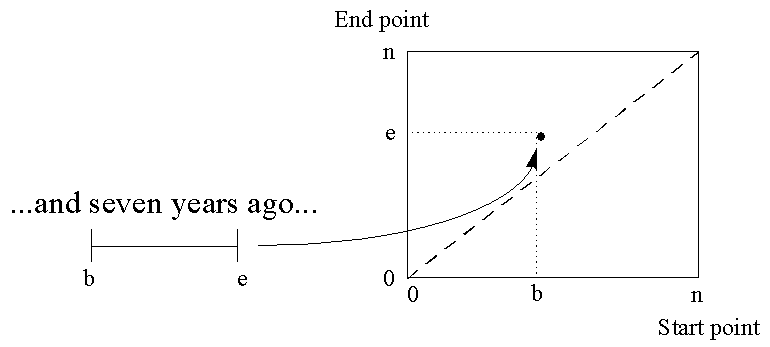
|
|
Figure 5: A region [b,e] corresponds to a point in region space.
|




It remains to choose a representation for the collection of region intervals that provides the operations we need (region relations, union, and intersection).
A 2D geometric interpretation of regions will prove helpful. Any region [b,e] can be regarded as a point in the plane, where the x-coordinate indicates the start of the region and the y-coordinate indicates the end. We refer to this two-dimensional interpretation of regions as region space (see Figure 5). Strictly speaking, only points with integral coordinates correspond to regions, and even then only if they lie above the 45-degree line, where b <= e.

|
|
Figure 5: A region [b,e] corresponds to a point in region space.
|
A region set can be represented as a union of region intervals, which in turn can be represented as a union of axis-aligned rectangles in region space. We seek a data structure representing a union of rectangles with the following operations:
Ideally, these operations should take linear time and linear space. In other words, finding the intersection or union of a collection of M rectangles with a collection of N rectangles should take O(N+M+F) time (where F is the number of rectangles in the result), and computing a region relation on a collection of N rectangles should take O(N) time. The data structure itself should store N rectangles in O(N) space.
Research in computational geometry and multidimensional databases has developed a variety of data structures and algorithms for storing and intersecting collections of rectangles, including plane-sweep algorithms, k-d trees, quadtrees of various kinds, R-trees , and R+-trees (see [24] for a survey).
LAPIS uses a variant of the R-tree [9]. The R-tree is a balanced tree derived from the B-tree, in which each internal node has between m and M children for some constants m and M. The tree is kept in balance by splitting overflowing nodes and merging underflowing nodes. Rectangles are associated with the leaf nodes, and each internal node stores the bounding box of all the rectangles in its subtree. The decomposition of space provided by an R-tree is adaptive (dependent on the rectangles stored) and overlapping (nodes in the tree may represent overlapping regions). To keep lookups fast, the R-tree insertion algorithm attempts to minimize the overlap and total area of nodes using various heuristics (for example, inserting a new rectangle in the subtree that would increase its overlap with its siblings by the least amount). One set of heuristics, called the R*-tree [4], has been empirically validated as reasonably efficient for random collections of rectangles. Initially we used the R*-tree heuristics in our prototype. The rectangle collections generated by text constraints are not particularly random, however; they tend to be distributed linearly along some dimension of region space, such as the 45-degree line, the x-axis, or the y-axis. We were able to improve overall performance by a factor of 5 by simply ordering the rectangles in lexicographic order, eliminating the expensive calculations that decide where to place a rectangle without sacrificing the tree's logarithmic decomposition of region space.
Two R-trees T1 and T2 can be intersected by traversing the trees in tandem, comparing the current T1 node with the current T2 node and expanding the nodes only if their bounding boxes overlap. Traversing the trees in tandem has the potential for pruning much of the search, since if two nodes high in each tree are found to be disjoint, the rectangles stored in their subtrees will never be compared. In practice, tandem tree intersection takes time O(N+M+F). It will never do worse than O(NM). Tandem tree traversal is effective for implementing set intersection, union, and difference.


